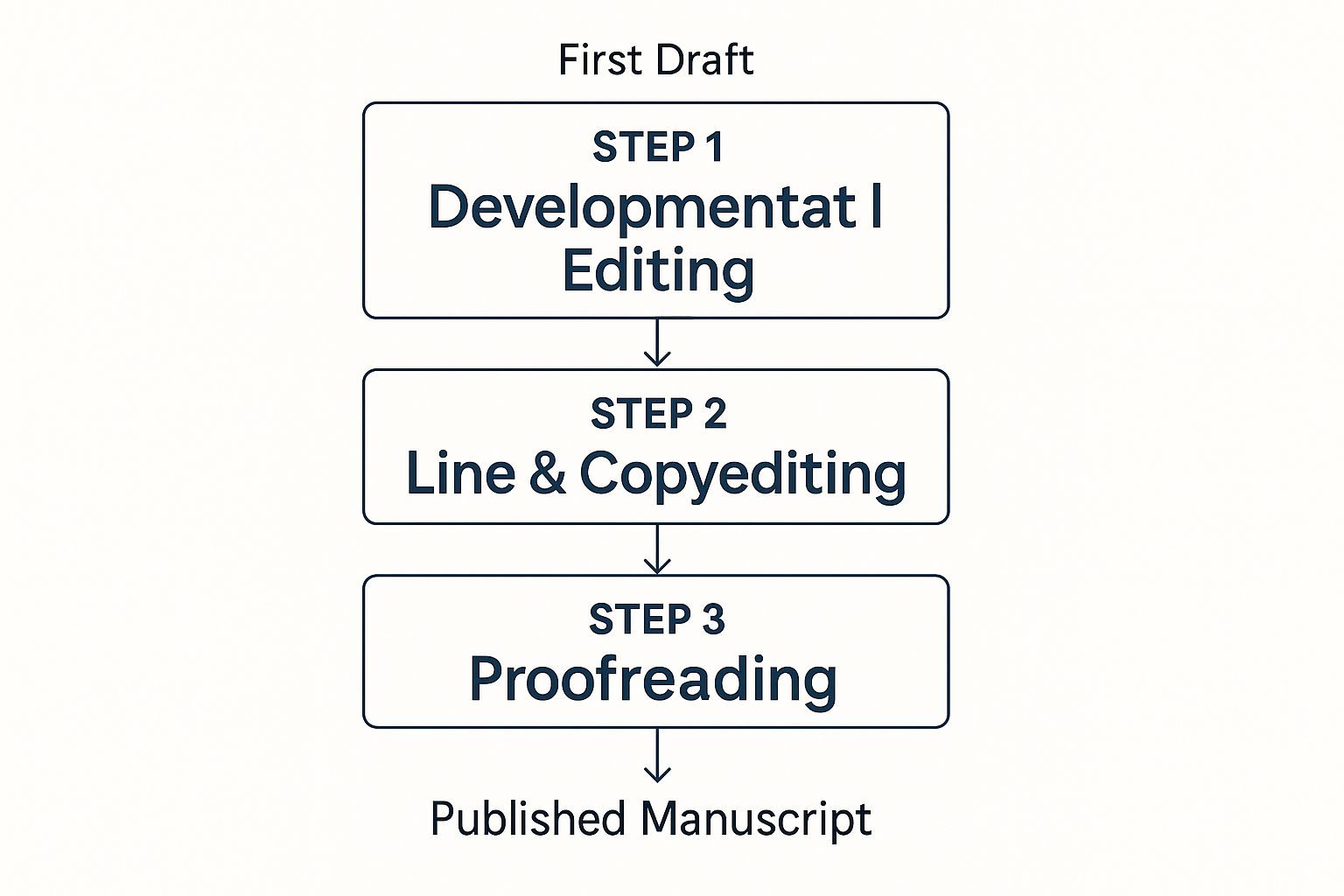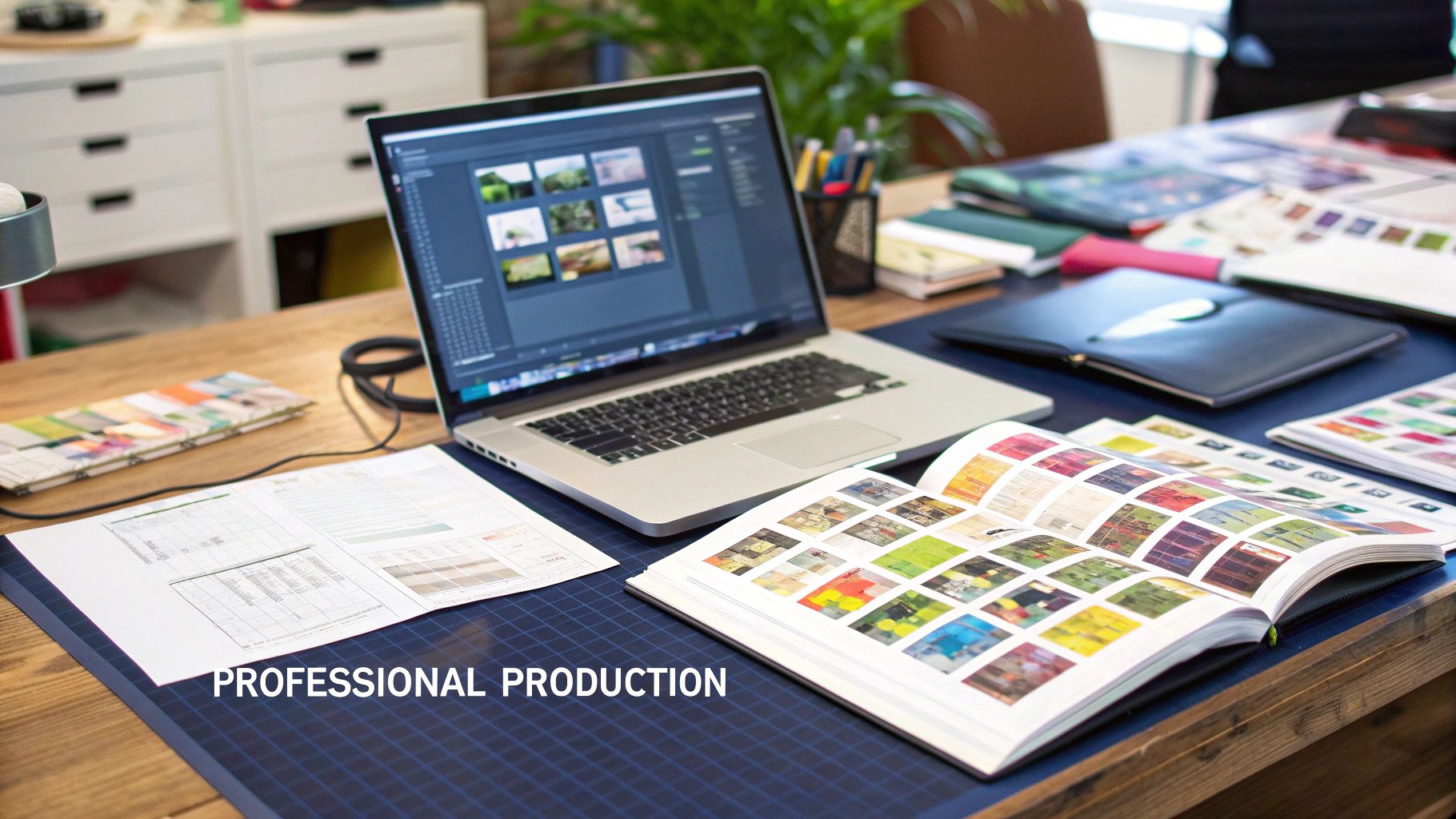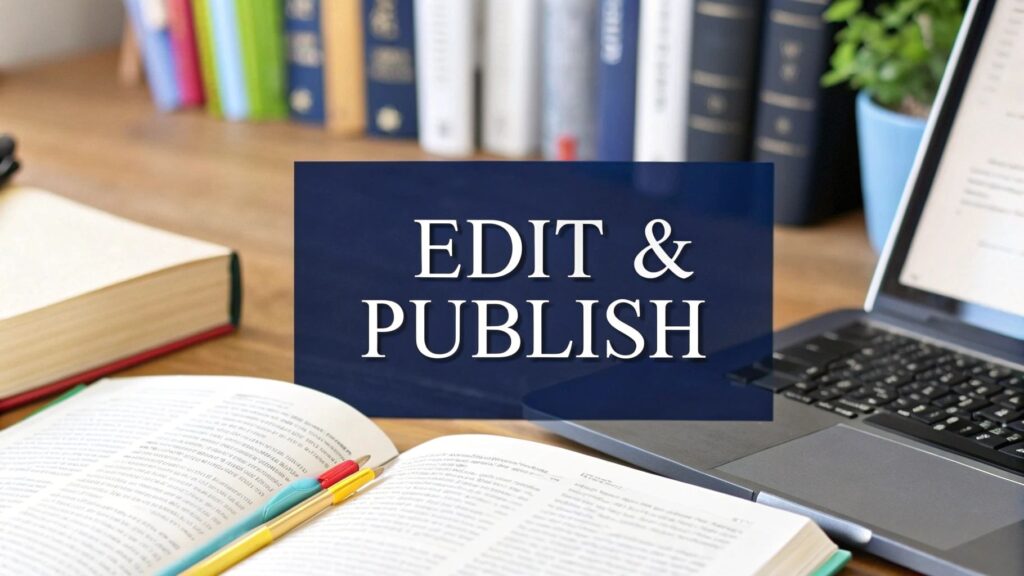So, you've poured your heart and soul into a manuscript. Congratulations—that's a monumental achievement! But getting those words on the page is really just the beginning of the journey. Now, the real work begins: turning that raw draft into a polished, professional book that's ready for readers.
This is where the multi-layered world of book editing comes in. It's a process that moves from the big-picture story down to the tiniest details of punctuation. Skipping these steps is probably the single biggest mistake I see new authors make. It undermines all their hard work and can stop a great story from ever finding its audience.
Think of it as building a house. You wouldn't paint the walls before the foundation is set and the framing is secure, right? It’s the same with a book.
This infographic breaks down that "construction" process, showing how each phase of editing builds on the last.

As you can see, it's a systematic process designed to refine your manuscript at every level, from its core structure to its final presentation.
Let's walk through what each of these editing stages actually looks like in practice. Here's a quick overview of the four core stages every manuscript goes through with a professional editor.
The Four Core Stages of Professional Book Editing
| Editing Stage | Main Focus | When It's Done |
|---|---|---|
| Developmental Editing | Big-picture elements: plot, character arcs, pacing, structure, and overall concept. | First, on a completed (but still rough) manuscript. |
| Line Editing | The craft of writing: voice, style, flow, rhythm, and clarity at the sentence level. | After the developmental edits are complete. |
| Copyediting | Technical correctness: grammar, spelling, punctuation, and consistency. | After line edits are implemented. |
| Proofreading | Final quality check: typos, formatting errors, and layout issues. | Last, on the final, formatted version before printing. |
Each stage is crucial and serves a completely different purpose. Trying to do them all at once—or out of order—is a recipe for chaos.
Start with the Foundation: Developmental Editing
This is where you zoom all the way out. Developmental editing is the first, and arguably most important, stage. It's not about commas or word choice; it's about the very bones of your story.
A developmental editor is your first critical reader, and they ask the tough questions:
- Is the plot working? They'll hunt for plot holes, sagging middles, or an anticlimactic ending.
- Are the characters compelling? They analyze motivations, character arcs, and whether their actions feel authentic.
- How's the pacing? You might get feedback on where to trim slow scenes or expand moments of high tension to keep readers hooked.
- Does the structure hold up? For a non-fiction book, this means looking at the logical flow of your arguments and how chapters are organized.
I once worked with a debut novelist whose manuscript was brilliant in parts but just… dragged in the middle. The developmental editor pointed out that a key supporting character vanished for about 100 pages, which made the central conflict feel stagnant. That single piece of feedback led to a restructuring that wove the character back in, and it completely transformed the book.
Think of it this way: Developmental editing makes sure your story's foundation is solid. Fixing plot or character issues here saves you from having to tear down the walls after you've already painted them.
Refine Your Craft with Line and Copyediting
With a solid structure in place, you can finally zoom in on the language itself. This phase is often a one-two punch of line editing and copyediting.
Line editing is all about style and artistry. A line editor focuses on how your sentences sound and feel. They’ll help you eliminate awkward phrasing, cut clichés, and vary your sentence structure so your unique voice can really sing. This is where your prose gets its polish and power. To get the most out of this stage, it helps to constantly improve your English writing skills through practice and reading.
Copyediting, on the other hand, is the technical side of the coin. Your copyeditor is a stickler for the rules. They’re meticulously checking for errors in:
- Grammar, syntax, and punctuation
- Spelling and typos
- Consistency (Is a character’s name spelled the same way in Chapter 3 and Chapter 23?)
- Adherence to a style guide (most commonly, The Chicago Manual of Style)
For authors ready to bring in an expert, there are many professional book editing services that offer specialized help for each of these distinct stages.
The Final Check: Proofreading
Okay, the story is solid, the prose is sparkling, and the grammar is perfect. You’re almost there. After the book has been designed and formatted for printing, it's time for one last look: the proofread.
Proofreading is the final safety net. A proofreader's sole job is to catch any small, lingering errors that were either missed in previous rounds or—and this happens all the time—introduced during the typesetting and design phase.
They’re hunting for typos, formatting glitches like weird line breaks, and incorrect page numbers. A fresh set of eyes is absolutely essential here, which is why the proofreader is almost never the same person who did the copyedit. This final pass ensures the reader has a smooth, error-free experience from cover to cover.
Choosing Your Path to Publication

After all the sweat and late nights, your manuscript is finally polished. It’s ready. Now you’ve arrived at a fork in the road, and the decision you make next will shape your entire career as an author.
You have two main options: traditional publishing or self-publishing.
Let’s be clear: neither one is inherently "better." They're just different. One offers prestige and a built-in team, while the other offers total control and higher royalties. The right choice really comes down to your personal goals, your book's specific needs, and how much of an entrepreneur you’re ready to be.
The Traditional Publishing Route
This is the path most people picture—the one you see in the movies. You partner with a publishing house that fronts the money to produce, print, market, and distribute your book. To get your foot in that door, you almost always need a literary agent.
The journey looks a bit like this:
- You write a killer query letter. This is your one-page sales pitch. It needs to be sharp, professional, and compelling.
- You research and target agents. You’ll spend hours building a list of agents who represent books in your genre, carefully following their submission guidelines.
- You send out your queries. And then you wait. You’ll send out dozens, maybe even hundreds, of queries. Rejection is just part of the game here, so thick skin is a must.
If an agent falls in love with your manuscript, they'll sign you and then pitch your book to editors at publishing houses. If an editor makes an offer, you get a contract and, usually, an advance.
An advance isn't a bonus; it's a pre-payment on your future royalties. You won't see another penny from sales until your book earns back that full amount for the publisher. This is called "earning out."
The upsides are huge. You get professional support at every stage, wide distribution into physical bookstores, and the credibility that comes with a publisher's name on your book's spine. The trade-off? You give up a lot of control over things like the cover, the title, and marketing decisions. And the whole process can easily take a couple of years from signing to launch.
The Self-Publishing Revolution
Self-publishing used to have a bit of a stigma, but those days are long gone. It’s now a powerful and respected part of the industry that puts you completely in charge.
As a self-published author, you are the publisher. You hire your own team of freelancers—an editor, a cover designer, a formatter—and upload your finished book directly to retail platforms like Amazon KDP.
This path gives you 100% creative control and much higher royalty rates. We’re talking up to 70% on ebooks, a massive jump from the typical 10-25% in a traditional deal.
Of course, with that control comes a ton of responsibility. Every single task is on you:
- Project Management: You’re in charge of the entire production schedule.
- Financial Investment: You pay for everything—editing, design, marketing—out of your own pocket.
- Marketing and Promotion: It's entirely up to you to build an audience and sell your book.
You essentially become the CEO of your own little publishing company. It demands a business mindset and a real willingness to learn how to market yourself. Our guide on how to become a published author digs much deeper into the practical steps for both paths.
Making the Right Choice for Your Book
So, how do you decide? Let’s walk through a couple of real-world scenarios.
Scenario 1: The Genre-Bending Novelist
You've written a brilliant sci-fi fantasy romance that doesn't fit neatly into any single box. A traditional publisher might see this as a risk because they don't know which shelf to put it on in a bookstore. An agent might pass, fearing it's too difficult to sell.
- Best Path: Self-publishing. This is where you can shine. You can market your book directly to readers who love genre mashups. Use targeted ads on Facebook or build a following on TikTok to find your exact audience without needing a gatekeeper’s permission.
Scenario 2: The Expert with a Niche Non-Fiction Book
Imagine you’re a history professor who has written a deep-dive book on a very specific military conflict. Your primary goal is to establish credibility, get it into university libraries, and reach fellow academics. You don't have a big social media following or the time to learn digital marketing.
- Best Path: Traditional publishing. A university press or a traditional non-fiction imprint has the built-in distribution network and institutional clout you need. Their sales team knows exactly how to get your book into the academic channels where it will have the most impact.
At the end of the day, this is a business decision. Take a hard look at your personal strengths, your finances, and what you truly want to achieve as an author before you take your next step.
Getting Your Book Ready for Production

It’s easy to think you’ve crossed the finish line after those grueling rounds of edits. But what you’ve really done is arrive at a new starting line: the production phase of the book editing and publishing process. This is where your edited Word document transforms into a real, tangible product—a book that someone can hold in their hands or download to their e-reader.
The details here are everything. They’re what separate a project that looks self-published from a polished, professional book that can compete with the big guys. This isn't just about making things look pretty; it's about creating an immersive, seamless experience for your reader, from the second they see the cover to the final page.
Designing a Cover That Actually Sells
Let's be blunt: your book cover is your most critical marketing tool. Period. Before anyone reads a single word you’ve written, they will absolutely judge your book by its cover. A professional design is a signal of quality, and it instantly tells a potential reader what kind of book they’re looking at.
One of the most common rookie mistakes I see is an author trying to design their own cover or, just as bad, hiring the cheapest designer they can find on a gig site. This almost always ends in disappointment. A cover that works has to do three things really well:
- Fit the genre: A thriller cover has a completely different vibe than a romance or a business book. Your design has to meet the expectations of readers in your specific category.
- Be legible as a thumbnail: Think about it—most people will first see your cover as a tiny image while scrolling through Amazon. If the title is unreadable or the imagery is a muddy mess at that size, you’ve lost the sale.
- Nail the mood: Is your story mysterious? Uplifting? Scholarly? The colors, the fonts, the imagery—they all have to work together to broadcast the feeling of your book.
A great cover isn't just decoration; it's your silent salesperson, working around the clock. Investing in a professional designer who knows your genre is one of the smartest moves you can make.
Perfecting the Interior Layout and Typesetting
How the words look on the page has a massive impact on the reading experience. This whole process is called interior formatting or typesetting, and trust me, it’s a genuine craft. The goal is to create a clean, readable layout that feels so natural the reader doesn't even notice it.
This means making very intentional choices about a few key elements, and the considerations are a bit different for print versus digital.
| Element | Print Book Focus | Ebook Focus |
|---|---|---|
| Fonts | I typically recommend a classic, readable serif font (like Garamond) for the main text and a clean sans-serif for headings. | It’s all about web-safe fonts that will look good on any device, from a Kindle to a smartphone. |
| Margins | You have to get the inner margins (the "gutters") right so the text doesn’t get sucked into the spine. | The text needs to be "reflowable," meaning it automatically adjusts to whatever screen size or font setting the reader chooses. |
| Spacing | It’s a delicate balance of line spacing (leading), paragraph indents, and chapter breaks to create a page that’s easy on the eyes. | You need clean code (HTML/CSS) to ensure spacing is consistent, avoiding fixed layouts that break on small screens. |
When you nail the formatting, your book feels like it came from a major publisher. That builds a subconscious layer of trust with the reader before they even start chapter one.
Handling the Technical Nitty-Gritty
Beyond the design, a few technical pieces have to be in place. These are the behind-the-scenes essentials that make your book a legitimate, discoverable product in the marketplace.
First up, you need an ISBN (International Standard Book Number). Think of this 13-digit code as your book's Social Security number. It’s a unique identifier, and you’ll need a separate one for every single format: one for the paperback, another for the ebook, one for the hardcover, and so on.
Next is your book metadata. This is all the information you feed to retailers like Amazon to tell them what your book is about. You have to get this right. The key parts are:
- Title and Subtitle: Make them crystal clear and sprinkle in keywords people might actually search for.
- Book Description: This is your sales pitch! It needs to hook the reader, lay out the core problem or promise of the book, and finish with a nudge to buy it.
- Categories and Keywords: Choosing hyper-specific, relevant categories and keywords is how you get your book in front of the right readers. Don't be generic here.
Finally, for print books, you'll pick a trim size (e.g., 6"x9" is standard for novels, while 8.5"x11" works for workbooks) and paper type. These choices directly impact your printing costs and the physical feel of the book, which all contribute to that perception of quality.
Connecting with Readers Through Smart Marketing

With a beautifully designed book ready to go, you've reached a pivotal moment in the book editing and publishing process. Now, the real work begins: getting it into the hands of readers. Writing the book was one mountain to climb; finding its audience is the next. This means swapping your writer's hat for a marketer's, focusing on how people will discover and buy your work.
The exciting part is that authors have never had more control. The global book market is huge and still growing, with some estimates projecting it could hit $142.72 billion by 2025. This growth isn't just happening in one place; it's spread across traditional print, ebooks, and audiobooks. That means a smart, multi-channel approach is your best bet for success.
Mastering Distribution Channels
Your first big decision is where and how people can buy your book. For most indie authors, the sweet spot is using a combination of major platforms to get the widest reach possible—covering everything from ebooks to print-on-demand for bookstores and libraries.
- Amazon KDP (Kindle Direct Publishing): You simply can't ignore it. KDP is the undisputed king of ebooks, giving you direct access to the massive Kindle marketplace.
- IngramSpark: Think of this as your gateway to the rest of the book world. IngramSpark connects you to over 40,000 retailers and libraries, including major players like Barnes & Noble. It's how your print book becomes orderable almost anywhere.
- Direct-to-Reader Sales: A growing number of authors are cutting out the middleman and selling directly from their own websites using tools like Shopify or Payhip. The payoff? Higher profit margins and, crucially, direct access to your readers' email addresses—an absolute goldmine for building a loyal following.
A popular and effective strategy is to use KDP and IngramSpark together. Let KDP handle your Amazon sales to get the best royalty rates there, then use IngramSpark for "expanded distribution" to reach every other retailer.
Here's a pro tip I can't stress enough: When you set up IngramSpark, be sure to opt out of Amazon distribution if you're already using KDP for that. This avoids any channel conflicts and makes sure you're getting the best possible return from each platform.
Building Your Author Platform
Great marketing isn't about shouting at everyone to buy your book. It's about building genuine relationships with the right people—the ones who will fall in love with your stories. This is your author platform, and it’s your home on the internet.
You don't need to be everywhere at once. Start by focusing on just one or two places where your ideal readers hang out.
- An Author Website: This is non-negotiable. It's your home base online. Make it easy for people to join your email list, find links to your books, and read a bit about you and your story.
- An Email Newsletter: This is your most valuable marketing asset, period. You own your email list, unlike your social media following. It's a direct line to your biggest fans for sharing news, behind-the-scenes content, and special offers.
- Social Media: Be strategic here. If you write fast-paced thrillers, X (formerly Twitter) might be a great fit. If your book is highly visual—like a cookbook or a fantasy epic with gorgeous maps—then Instagram or even Pinterest could be your best bet. If you want to dive deeper into this, check out this guide on how to use Pinterest for business.
Executing a Strategic Book Launch
A killer book launch is no accident. It’s a well-planned campaign designed to create a wave of excitement and drive a ton of sales right out of the gate. That initial burst of activity is critical because it signals to retailer algorithms that your book is worth paying attention to.
Here’s a rough sketch of a launch timeline:
- 90 Days Out: Lock in your final book files and cover design. Start reaching out to potential reviewers and assembling your ARC (Advance Reader Copy) team. Begin teasing the cover reveal.
- 60 Days Out: Get your book up for pre-order on all your chosen platforms. Send the ARCs to your team. Start mapping out your launch week promotions, like newsletter swaps or paid advertising.
- 30 Days Out: Ramp up your content on social media and in your newsletter. Share early reader reviews to build buzz and anticipation. For a more detailed plan, our article on building a book marketing strategy has you covered.
- Launch Week: It's go-time. Announce the launch everywhere. Run your ads, send your emails, and engage with every single person who mentions your book.
- Post-Launch: The marathon continues. Keep the momentum going with periodic promotions, continue seeking reviews, and nurture the community you've started to build.
Marketing isn't a one-and-done event. The real goal is to create a sustainable system that keeps introducing your work to new readers, long after the confetti of launch day has settled.
Adapting to the Future of Publishing
The world of book editing and publishing is always in motion. What worked five years ago might not work today, and what works today will almost certainly evolve. Reader habits, new tech, and different business models constantly reshape the landscape, creating new challenges and incredible opportunities for authors.
If you want a long-term, sustainable career, you have to keep an eye on the horizon. Understanding where the industry is headed helps you make smarter choices right now, from how you produce your book to the way you find and connect with your audience. The authors who will still be thriving in the years to come are the ones who stay curious, flexible, and willing to try new things.
The Expanding Role of AI
Let's start with the biggest disruptor: artificial intelligence. AI has moved far beyond just catching typos and is now stepping into more creative and strategic roles. Think of it less as a replacement for the author and more as a powerful assistant that can seriously level up your publishing game.
We're already seeing this happen in a few key ways:
- Smarter Marketing: AI can dig into reader data to help you build laser-focused ad campaigns on platforms like Amazon and Meta. This saves a ton of time and helps you get a much better return on your ad spend.
- Spotting Trends: Sophisticated tools can now scan the market to pinpoint hot new subgenres or see which cover design trends are clicking with readers. These are insights that used to be the exclusive domain of big publishing houses.
- Marketing Content Creation: While it's not going to write your next novel, AI can be a lifesaver when you're stuck on a book description, ad copy, or a batch of social media posts. It's a great way to break through marketing-related writer's block.
The influence of technology, and AI in particular, is undeniable. The global publishing market is expected to grow by a staggering USD 18.9 million between 2025 and 2029. This growth is being fueled by an insatiable demand for diverse content and the continued rise of self-publishing. Major players like Amazon and Adobe are already integrating AI for content creation, personalized book recommendations, and marketing analytics, changing the very DNA of how books are made and sold. You can dig into more of the data on this AI-powered shift over on PR Newswire.
The Unstoppable Rise of Audiobooks
The audiobook boom isn't slowing down. For millions of people, listening is now the primary way they "read" books, fitting perfectly into commutes, gym sessions, and household chores. For authors, this means audio is no longer a "nice-to-have" format—it's an essential piece of your business.
If you don't have an audio version of your book, you're leaving a huge chunk of your potential audience on the table.
The question isn't if you should produce an audiobook anymore. It's how. While new AI narration technology is making production cheaper and more accessible, a talented human narrator can bring a story to life in a way that creates a much more immersive experience for the listener.
Thriving in the Subscription Economy
Services like Kindle Unlimited have completely changed the game for voracious readers and the authors who write for them. If you're in a popular genre like romance, sci-fi, or thrillers, enrolling your book in a subscription program can offer a steady stream of income and expose your work to a massive new audience.
But there's a catch. To be in Kindle Unlimited, you have to agree to an exclusivity period for your ebook. That means you can't sell it anywhere else. It’s a major strategic choice: do you go wide and sell on every platform, or do you go deep with a huge, dedicated subscription audience? There's no right answer—it all comes down to your genre, your backlist, and your long-term career goals.
Building a Direct Line to Your Readers
This might be the most important trend of all. When you rely only on Amazon or other retailers to sell your books, you're essentially building your business on someone else's property. One little algorithm change can completely tank your visibility overnight.
The real power lies in building a direct connection with your readers. An email list, a private community, a newsletter—these are assets you own and control. This allows you to speak directly to your biggest fans, the people who are genuinely excited for your next release and will help spread the word. This direct relationship is your ultimate insurance policy, protecting you from the whims of algorithms and creating a loyal fanbase that will stick with you for the long haul.
Your Top Publishing Questions, Answered
Navigating the world of editing and publishing brings up a lot of questions. It's completely normal to feel a bit overwhelmed by all the decisions ahead. Let's clear up some of the most common queries I hear from authors to give you the clarity you need to move forward with confidence.
How Much Does It Cost to Publish a Book?
This is usually the first question on every author's mind, and the most honest answer is: it really depends on the path you take.
If you’re aiming for a traditional publishing deal, your direct cost should be exactly $0. Seriously. The publisher foots the bill for everything—editing, cover design, printing, and marketing. If anyone claiming to be a "traditional" publisher or agent asks you for money upfront, that's a major red flag.
Self-publishing is a different story. Here, you're the investor. You can bootstrap the entire project for a few hundred dollars, but a fully professional production usually lands in the $5,000–$10,000+ range. Here’s where that money typically goes:
- Editing: This is your biggest and most important investment. A full suite of developmental editing, copyediting, and proofreading can run anywhere from $1,500 to $5,000, based on the length and complexity of your manuscript.
- Cover Design: Your cover is your #1 marketing tool. A professionally designed cover that can compete with traditionally published books will cost between $500 and $1,500. Don't skimp here.
- Interior Formatting: A clean, readable layout for both your print and ebook versions is crucial. Budget $250–$750 for a pro to handle this.
- Marketing: This cost is a total wildcard. You could spend $0 and rely on your own social media efforts, or you could invest thousands in a strategic ad campaign and PR push.
Do I Really Need a Literary Agent?
You only need an agent if your goal is to land a contract with one of the big traditional publishing houses. Think of agents as the industry's gatekeepers. They have the relationships to get your manuscript past the slush pile and onto the right editor's desk.
They work on commission, typically taking 15% of your earnings, which means they only make money when you do.
If you’re self-publishing or using a hybrid publisher, you don't need an agent. In those scenarios, you're either the project manager yourself or you're working directly with the publishing service you hired.
A quick but critical tip: A legitimate agent will never, ever charge you a reading fee. Their success is tied to yours, making them a true partner in the traditional publishing journey.
How Long Does the Whole Process Take?
Publishing is a marathon, not a sprint. The timeline depends entirely on the route you choose, so it's best to set your expectations accordingly.
- Traditional Publishing: Get ready to be patient. From the day you start querying agents to the day your book hits shelves, you're often looking at 18 months to 3 years. Just finding an agent can take months (or longer), submitting to publishers can take another year, and then the publisher's own production schedule adds another 9-12 months on top of that.
- Self-Publishing: Here, you're in the driver's seat. A determined author can take a polished manuscript from the start of editing to launch day in as little as 3-6 months. The biggest pitfall is rushing the crucial stages—a hurried edit or a slapped-together cover will show in the final product.
No matter which path you take, giving the process the time it deserves is key to producing a book you can be proud of.
Ready to tackle these steps with a team of experts in your corner? At BarkerBooks, we offer complete publishing support to transform your manuscript into a book available worldwide. We'll manage the complexities, so you can focus on your writing. Learn more about our all-inclusive publishing packages today!
